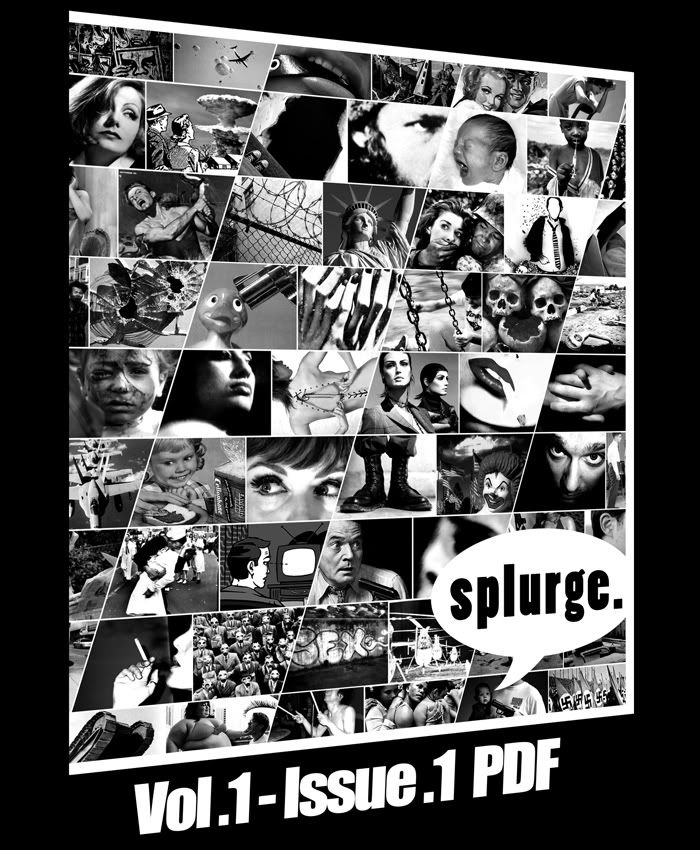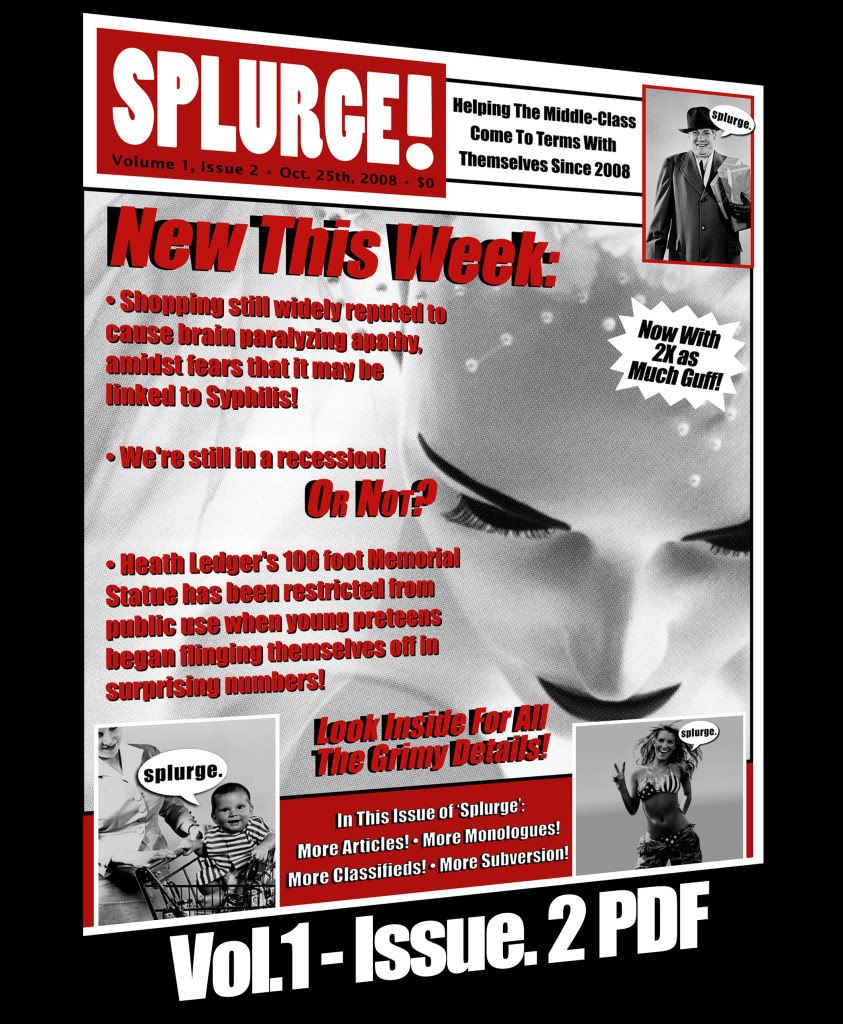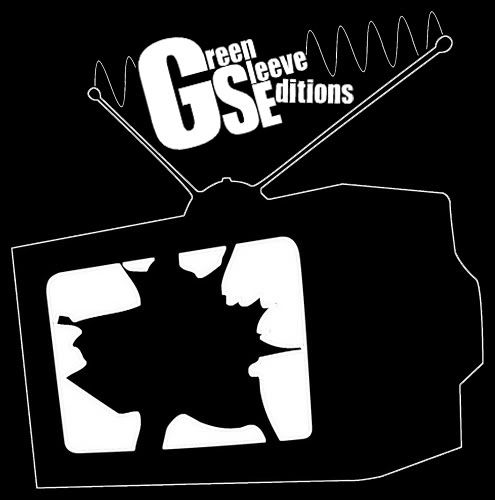
Welcome to the Weboutlet for Splurgezine.
To join the facebook group, click here.
To download Volume 1, Issue 1 or 2, simply click on the image below.


Splurge is best viewed from Adobe Reader. You can download free Mac and PC Versions here.
There appears to be PDF downloading issues for Mac users running the Safari web browser. If having problems with Safari, you can download Firefox here.
9.4.08
Specific Specifics, Specified!

Here's a little background information on the charities and what they need from you on Sunday, April 13th.
Edmonton Street News Background:
Edmonton Street News is an independent publication produced by volunteers and sold by vendors on the street. ESN is produced by a small group of volunteers, and as such, money is needed to pay for printing costs and to cover other expenses such as vendor badges, stamps, envelopes, gas, printer cartridges, bank fees etc. Edmonton Street News is the only street news paper in the city that provides an actual voice for the homeless and those marginalized by poverty; a perspective from those inside the problems, as opposed to a view of an outsider-looking-in.
What Edmonton Street News needs most from you:
- Cash donations
- Your Thirst! (for every Big Rock pint sold on the 13th, Big Rock is donating $1 to ESN)
The Food Bank Background:
Edmonton’s Food Bank was born through the realisation of two factors by a small number of individuals from various local non-profit organizations: hunger was affecting the lives of many of their clients and edible food was being wasted in the community. There was a desire to reconcile these realities and to establish a channel for surplus food from the food industry to those who were experiencing food insecurity.
In April 1980, an ad hoc committee began investigating the possibility of establishing a food bank to serve agencies located in the inner city. Interest was high among these agencies to provide meal or snack programs to people in need. With funding provided by the Marian Centre, an official from Second Harvest Food Bank (Phoenix, Arizona) was asked to attend a workshop to provide his expertise. Following several meetings, an official steering committee was appointed by the participating agencies to carry out the planning for the Food Bank until the organization became legally incorporated and an official Board of Directors was elected.
On January 16, 1981, the Edmonton Gleaners Association, more commonly known as Edmonton’s Food Bank, received it’s official charter of incorporation and Canada’s first food bank was born.
What the Food Bank needs most from you:
Edmonton’s Food Bank was born through the realisation of two factors by a small number of individuals from various local non-profit organizations: hunger was affecting the lives of many of their clients and edible food was being wasted in the community. There was a desire to reconcile these realities and to establish a channel for surplus food from the food industry to those who were experiencing food insecurity.
In April 1980, an ad hoc committee began investigating the possibility of establishing a food bank to serve agencies located in the inner city. Interest was high among these agencies to provide meal or snack programs to people in need. With funding provided by the Marian Centre, an official from Second Harvest Food Bank (Phoenix, Arizona) was asked to attend a workshop to provide his expertise. Following several meetings, an official steering committee was appointed by the participating agencies to carry out the planning for the Food Bank until the organization became legally incorporated and an official Board of Directors was elected.
On January 16, 1981, the Edmonton Gleaners Association, more commonly known as Edmonton’s Food Bank, received it’s official charter of incorporation and Canada’s first food bank was born.
What the Food Bank needs most from you:
- Beans with or without pork
- Canned meat
- Canned fish
- Canned fruit or vegetables
- Peanut butter
- Powdered milk
- Baby food and formula
- Macaroni and cheese dinners
- Pasta and pasta sauce
- School snack items such as juice boxes and granola bars
The Bissell Centre Background:
The growth of urban centres brought new social challenges. Immigrants arrived while in transit to a place in the country, young men came to the city to earn money in order to support the voyage of their family, and many returned from the country side to find work during winter, hoping to supplement their meager farm income.
In 1910 an urban mission was established in Edmonton by the Methodist minister William Pike and his wife, Florence. The mission was located on the North-west corner of 96th Street and 103A Avenue, where the present Police Station now stands. The mission offered language programs, a place to socialize and religious services. Some years later, the Presbyterian Church also built a mission in the vicinity. The logical direction—joint programs and services—was taken in 1919. The McQueen Institute came into being, later, after the 1925 formation of the United Church of Canada, known as the All People's Mission. (In Winnipeg, nine "All Peoples Missions" operated through out the city since 1907, under the leadership of the Rev. J.S. Woodsworth). The mission grew and expanded programs for new mothers, children and youth, and during the 1930s added services for those on low income: a place to sleep, meals and clothing.
With the help of a legacy from Torrence E. Bissell new premises were prepared. Saturday night concerts were held every week. The old blacksmith's shop was demolished to make way for a new brick building, officially named The Bissell Institute. Church services were held every Sunday. During the war the Japanese congregation found a home here. This was made up of people who had been forced to leave their homes on the West coast.
As the city of Edmonton grew, the need for the programs offered at the Bissell Centre increased as well. More people on low income were living in poor housing than ever before. By the 1980's Bissell had once more outgrown its facility. In 1989 the Centre moved to a renovated warehouse a few blocks north.
Today, nearing a century of missionary service, the vision of the Bissell Centre is to make Edmonton a city in which neighbour helps neighbour to find wholeness.
The growth of urban centres brought new social challenges. Immigrants arrived while in transit to a place in the country, young men came to the city to earn money in order to support the voyage of their family, and many returned from the country side to find work during winter, hoping to supplement their meager farm income.
In 1910 an urban mission was established in Edmonton by the Methodist minister William Pike and his wife, Florence. The mission was located on the North-west corner of 96th Street and 103A Avenue, where the present Police Station now stands. The mission offered language programs, a place to socialize and religious services. Some years later, the Presbyterian Church also built a mission in the vicinity. The logical direction—joint programs and services—was taken in 1919. The McQueen Institute came into being, later, after the 1925 formation of the United Church of Canada, known as the All People's Mission. (In Winnipeg, nine "All Peoples Missions" operated through out the city since 1907, under the leadership of the Rev. J.S. Woodsworth). The mission grew and expanded programs for new mothers, children and youth, and during the 1930s added services for those on low income: a place to sleep, meals and clothing.
With the help of a legacy from Torrence E. Bissell new premises were prepared. Saturday night concerts were held every week. The old blacksmith's shop was demolished to make way for a new brick building, officially named The Bissell Institute. Church services were held every Sunday. During the war the Japanese congregation found a home here. This was made up of people who had been forced to leave their homes on the West coast.
As the city of Edmonton grew, the need for the programs offered at the Bissell Centre increased as well. More people on low income were living in poor housing than ever before. By the 1980's Bissell had once more outgrown its facility. In 1989 the Centre moved to a renovated warehouse a few blocks north.
Today, nearing a century of missionary service, the vision of the Bissell Centre is to make Edmonton a city in which neighbour helps neighbour to find wholeness.
The growth of urban centres brought new social challenges. Immigrants arrived while in transit to a place in the country, young men came to the city to earn money in order to support the voyage of their family, and many returned from the country side to find work during winter, hoping to supplement their meager farm income.
In 1910 an urban mission was established in Edmonton by the Methodist minister William Pike and his wife, Florence. The mission was located on the North-west corner of 96th Street and 103A Avenue, where the present Police Station now stands. The mission offered language programs, a place to socialize and religious services. Some years later, the Presbyterian Church also built a mission in the vicinity. The logical direction—joint programs and services—was taken in 1919. The McQueen Institute came into being, later, after the 1925 formation of the United Church of Canada, known as the All People's Mission. (In Winnipeg, nine "All Peoples Missions" operated through out the city since 1907, under the leadership of the Rev. J.S. Woodsworth). The mission grew and expanded programs for new mothers, children and youth, and during the 1930s added services for those on low income: a place to sleep, meals and clothing.
With the help of a legacy from Torrence E. Bissell new premises were prepared. Saturday night concerts were held every week. The old blacksmith's shop was demolished to make way for a new brick building, officially named The Bissell Institute. Church services were held every Sunday. During the war the Japanese congregation found a home here. This was made up of people who had been forced to leave their homes on the West coast.
As the city of Edmonton grew, the need for the programs offered at the Bissell Centre increased as well. More people on low income were living in poor housing than ever before. By the 1980's Bissell had once more outgrown its facility. In 1989 the Centre moved to a renovated warehouse a few blocks north.
Today, nearing a century of missionary service, the vision of the Bissell Centre is to make Edmonton a city in which neighbour helps neighbour to find wholeness.
What the Bissell Centre needs most from you:
The growth of urban centres brought new social challenges. Immigrants arrived while in transit to a place in the country, young men came to the city to earn money in order to support the voyage of their family, and many returned from the country side to find work during winter, hoping to supplement their meager farm income.
In 1910 an urban mission was established in Edmonton by the Methodist minister William Pike and his wife, Florence. The mission was located on the North-west corner of 96th Street and 103A Avenue, where the present Police Station now stands. The mission offered language programs, a place to socialize and religious services. Some years later, the Presbyterian Church also built a mission in the vicinity. The logical direction—joint programs and services—was taken in 1919. The McQueen Institute came into being, later, after the 1925 formation of the United Church of Canada, known as the All People's Mission. (In Winnipeg, nine "All Peoples Missions" operated through out the city since 1907, under the leadership of the Rev. J.S. Woodsworth). The mission grew and expanded programs for new mothers, children and youth, and during the 1930s added services for those on low income: a place to sleep, meals and clothing.
With the help of a legacy from Torrence E. Bissell new premises were prepared. Saturday night concerts were held every week. The old blacksmith's shop was demolished to make way for a new brick building, officially named The Bissell Institute. Church services were held every Sunday. During the war the Japanese congregation found a home here. This was made up of people who had been forced to leave their homes on the West coast.
As the city of Edmonton grew, the need for the programs offered at the Bissell Centre increased as well. More people on low income were living in poor housing than ever before. By the 1980's Bissell had once more outgrown its facility. In 1989 the Centre moved to a renovated warehouse a few blocks north.
Today, nearing a century of missionary service, the vision of the Bissell Centre is to make Edmonton a city in which neighbour helps neighbour to find wholeness.
The growth of urban centres brought new social challenges. Immigrants arrived while in transit to a place in the country, young men came to the city to earn money in order to support the voyage of their family, and many returned from the country side to find work during winter, hoping to supplement their meager farm income.
In 1910 an urban mission was established in Edmonton by the Methodist minister William Pike and his wife, Florence. The mission was located on the North-west corner of 96th Street and 103A Avenue, where the present Police Station now stands. The mission offered language programs, a place to socialize and religious services. Some years later, the Presbyterian Church also built a mission in the vicinity. The logical direction—joint programs and services—was taken in 1919. The McQueen Institute came into being, later, after the 1925 formation of the United Church of Canada, known as the All People's Mission. (In Winnipeg, nine "All Peoples Missions" operated through out the city since 1907, under the leadership of the Rev. J.S. Woodsworth). The mission grew and expanded programs for new mothers, children and youth, and during the 1930s added services for those on low income: a place to sleep, meals and clothing.
With the help of a legacy from Torrence E. Bissell new premises were prepared. Saturday night concerts were held every week. The old blacksmith's shop was demolished to make way for a new brick building, officially named The Bissell Institute. Church services were held every Sunday. During the war the Japanese congregation found a home here. This was made up of people who had been forced to leave their homes on the West coast.
As the city of Edmonton grew, the need for the programs offered at the Bissell Centre increased as well. More people on low income were living in poor housing than ever before. By the 1980's Bissell had once more outgrown its facility. In 1989 the Centre moved to a renovated warehouse a few blocks north.
Today, nearing a century of missionary service, the vision of the Bissell Centre is to make Edmonton a city in which neighbour helps neighbour to find wholeness.
The growth of urban centres brought new social challenges. Immigrants arrived while in transit to a place in the country, young men came to the city to earn money in order to support the voyage of their family, and many returned from the country side to find work during winter, hoping to supplement their meager farm income.
In 1910 an urban mission was established in Edmonton by the Methodist minister William Pike and his wife, Florence. The mission was located on the North-west corner of 96th Street and 103A Avenue, where the present Police Station now stands. The mission offered language programs, a place to socialize and religious services. Some years later, the Presbyterian Church also built a mission in the vicinity. The logical direction—joint programs and services—was taken in 1919. The McQueen Institute came into being, later, after the 1925 formation of the United Church of Canada, known as the All People's Mission. (In Winnipeg, nine "All Peoples Missions" operated through out the city since 1907, under the leadership of the Rev. J.S. Woodsworth). The mission grew and expanded programs for new mothers, children and youth, and during the 1930s added services for those on low income: a place to sleep, meals and clothing.
With the help of a legacy from Torrence E. Bissell new premises were prepared. Saturday night concerts were held every week. The old blacksmith's shop was demolished to make way for a new brick building, officially named The Bissell Institute. Church services were held every Sunday. During the war the Japanese congregation found a home here. This was made up of people who had been forced to leave their homes on the West coast.
As the city of Edmonton grew, the need for the programs offered at the Bissell Centre increased as well. More people on low income were living in poor housing than ever before. By the 1980's Bissell had once more outgrown its facility. In 1989 the Centre moved to a renovated warehouse a few blocks north.
Today, nearing a century of missionary service, the vision of the Bissell Centre is to make Edmonton a city in which neighbour helps neighbour to find wholeness.
What the Bissell Centre needs most from you:
- Warm Winter Jackets
- Sweaters
- Gloves
- Toques
- Footwear (in good condition)
- Socks (new)
All of these charities and organizations need our help!
Please bring any mix of donations to the release party to get a copy of the magazine.
0 Comments:
SPLURGE is a zine that decodes and defaces the ostentation
of modern consumer culture: by any means necessary.
